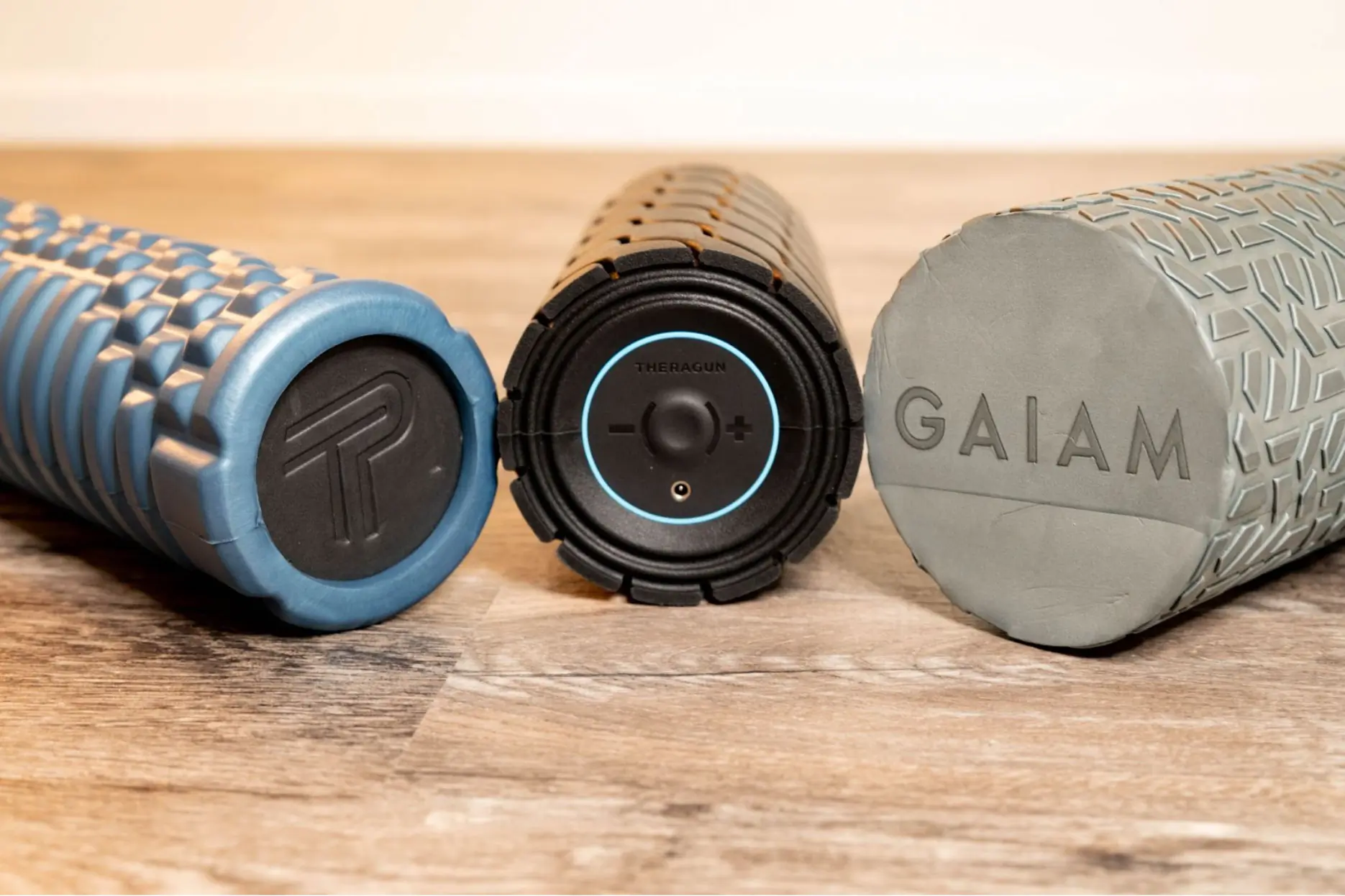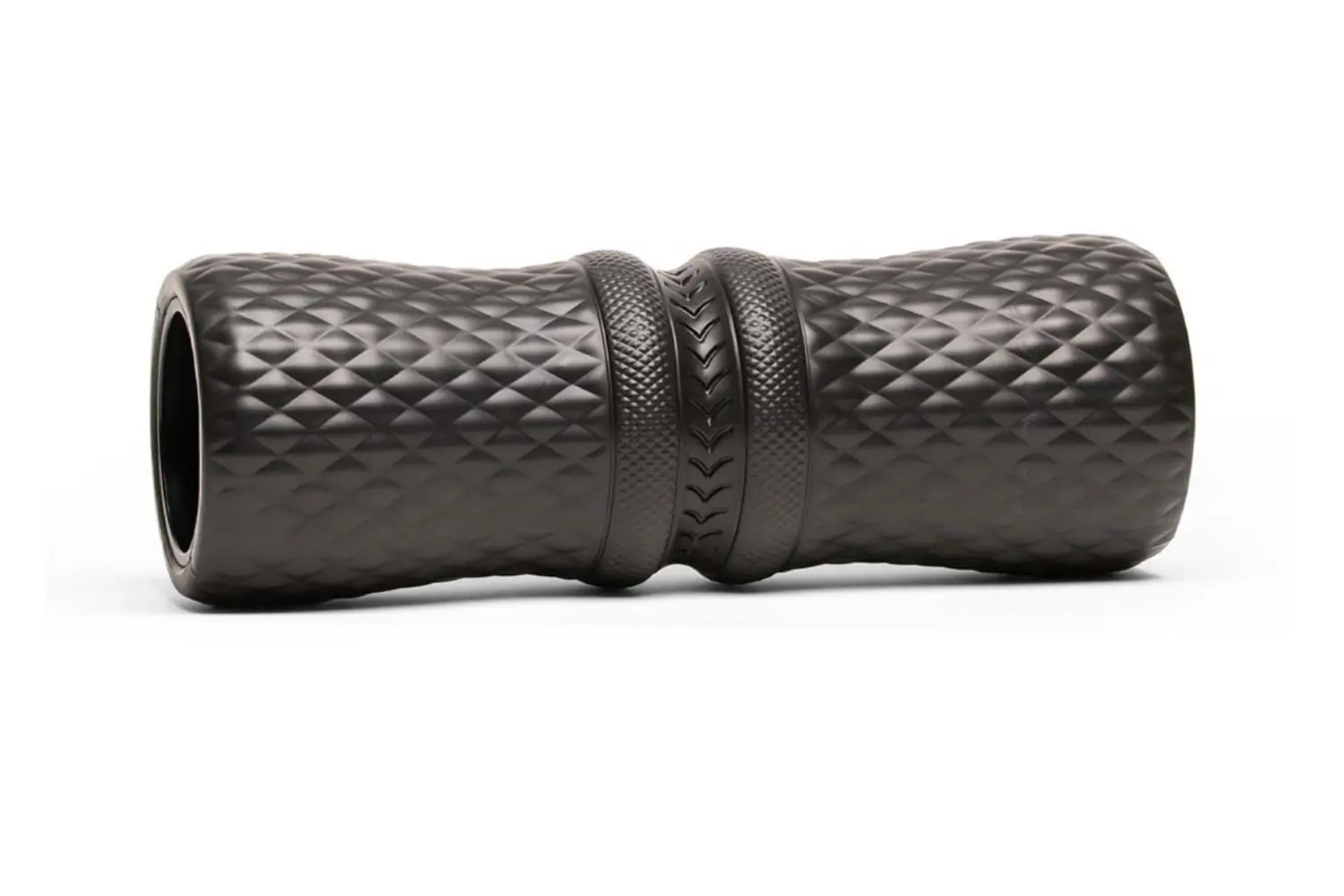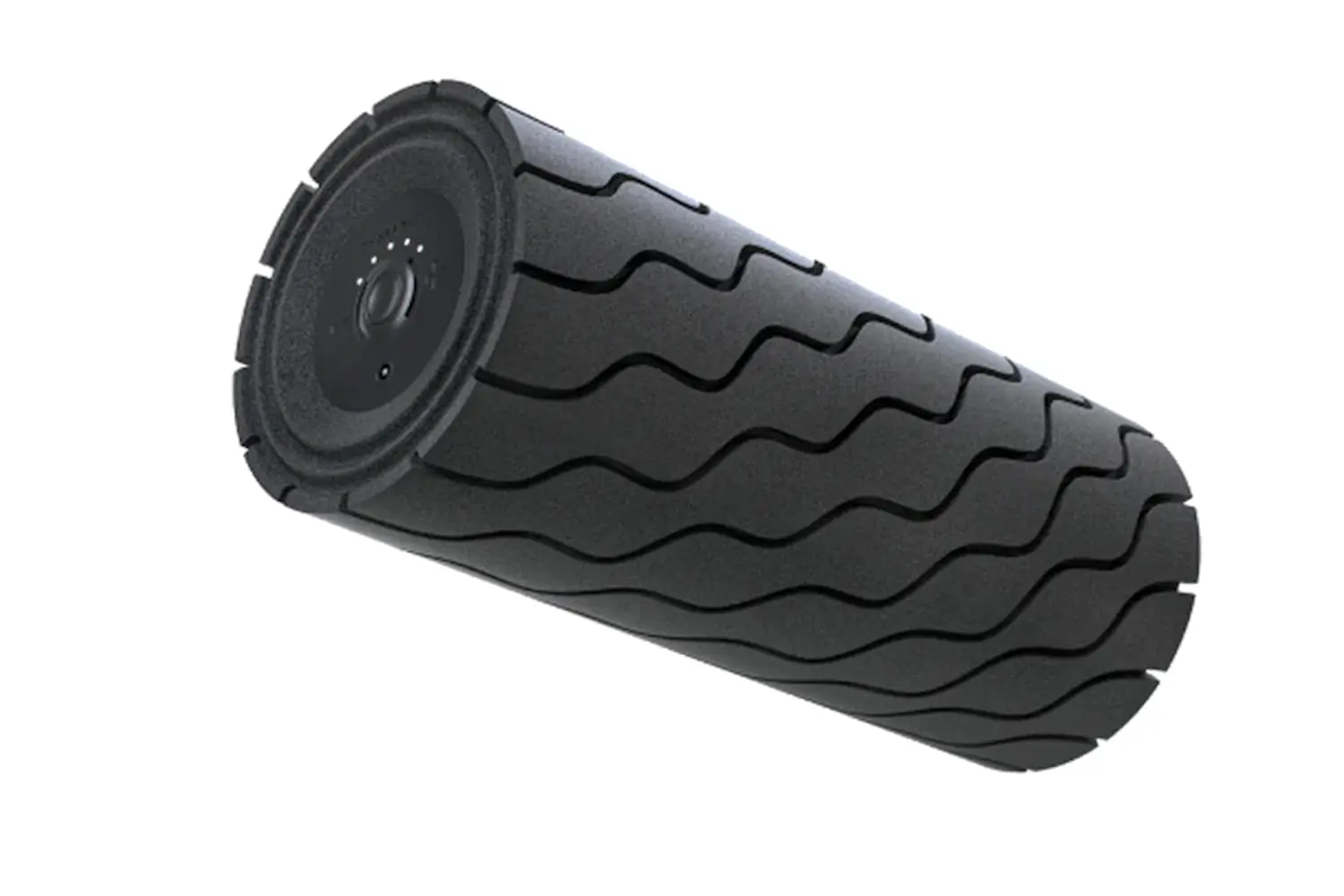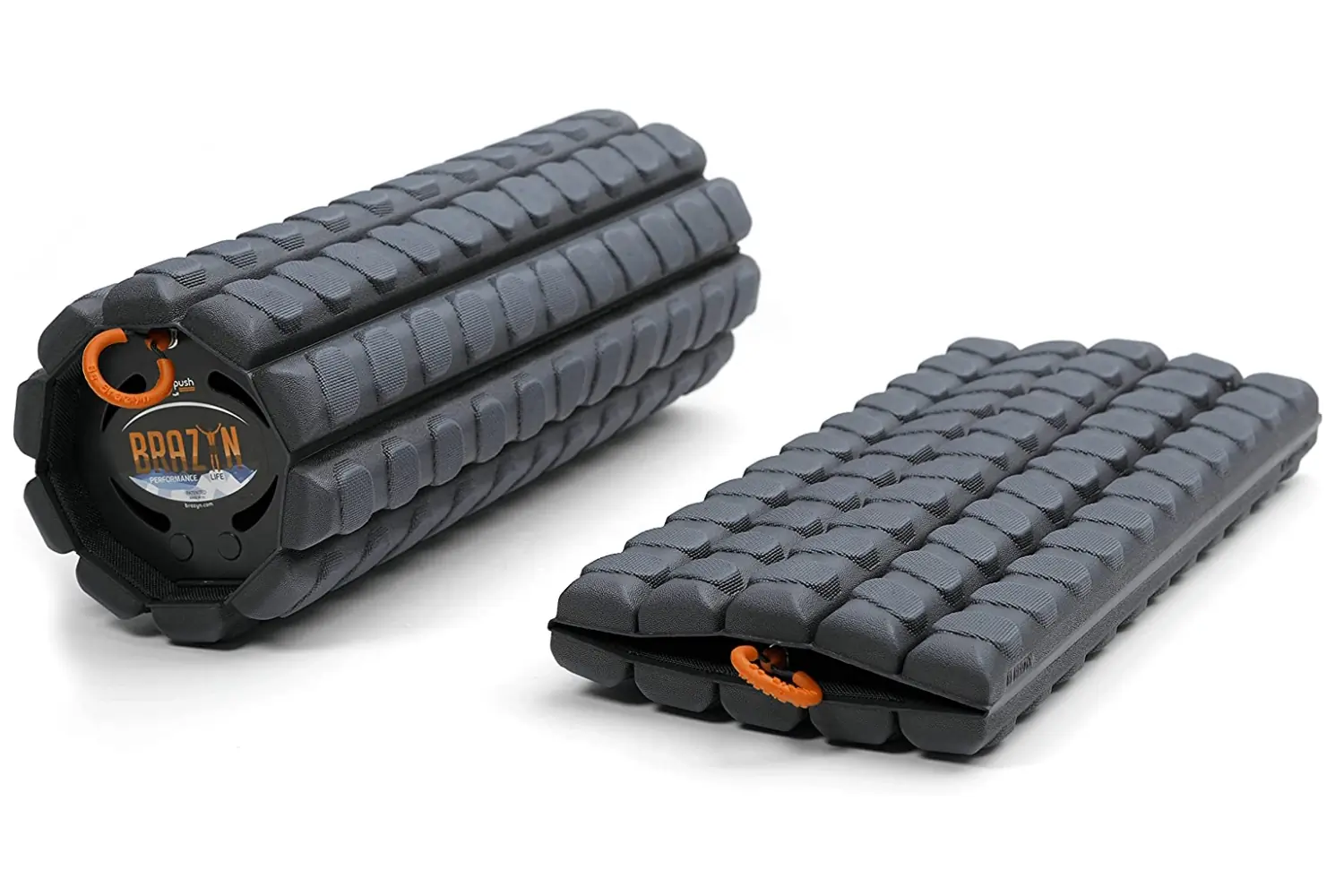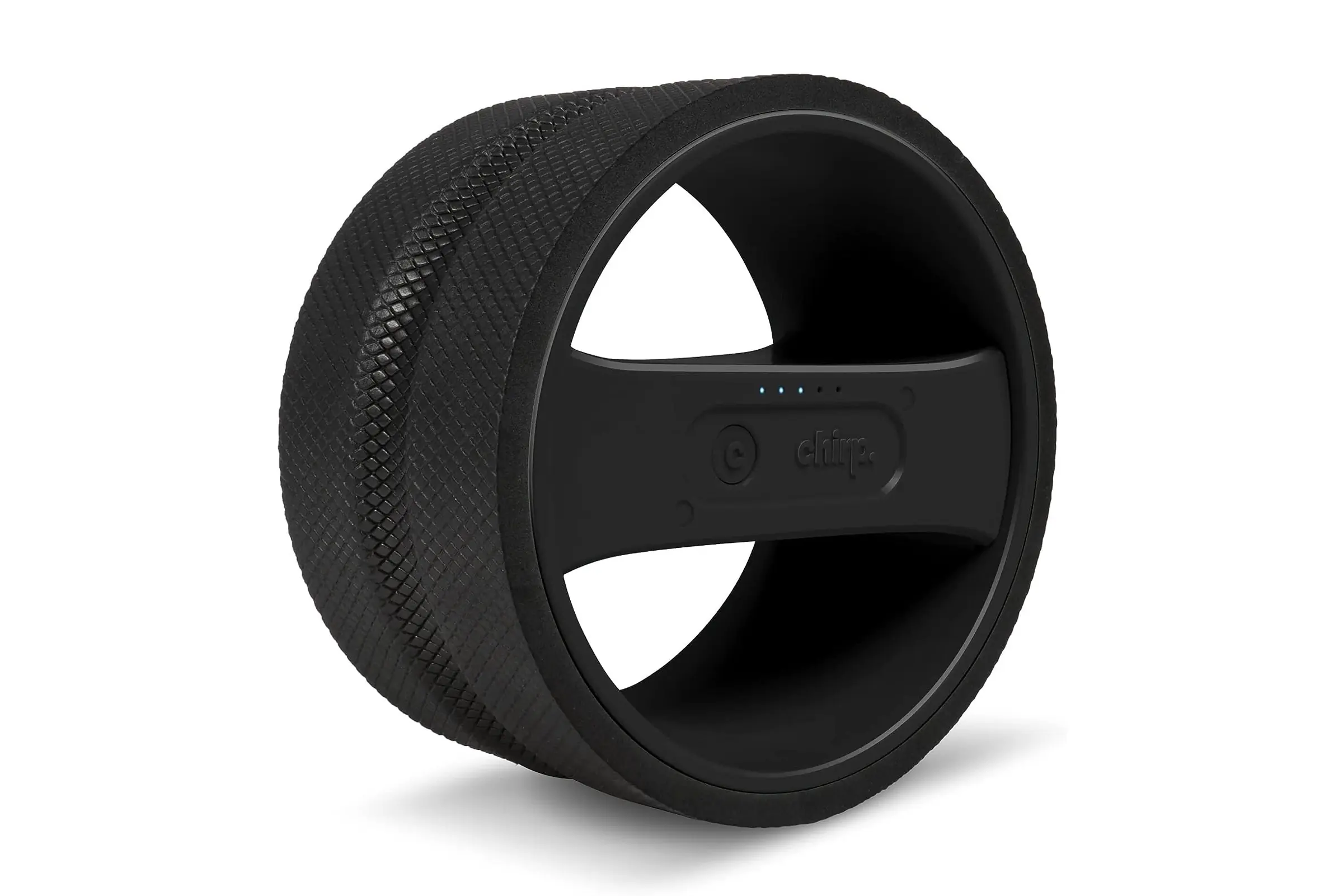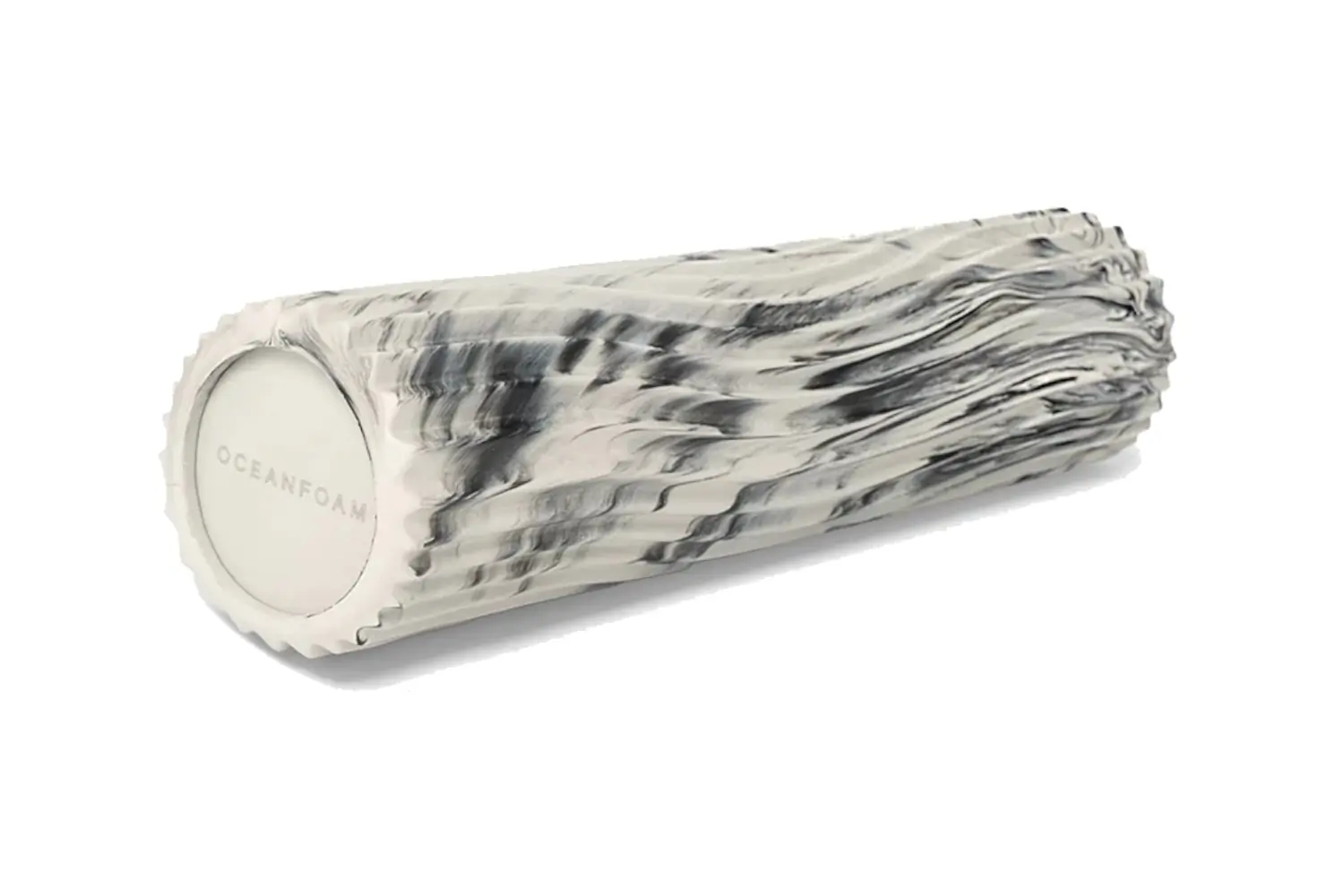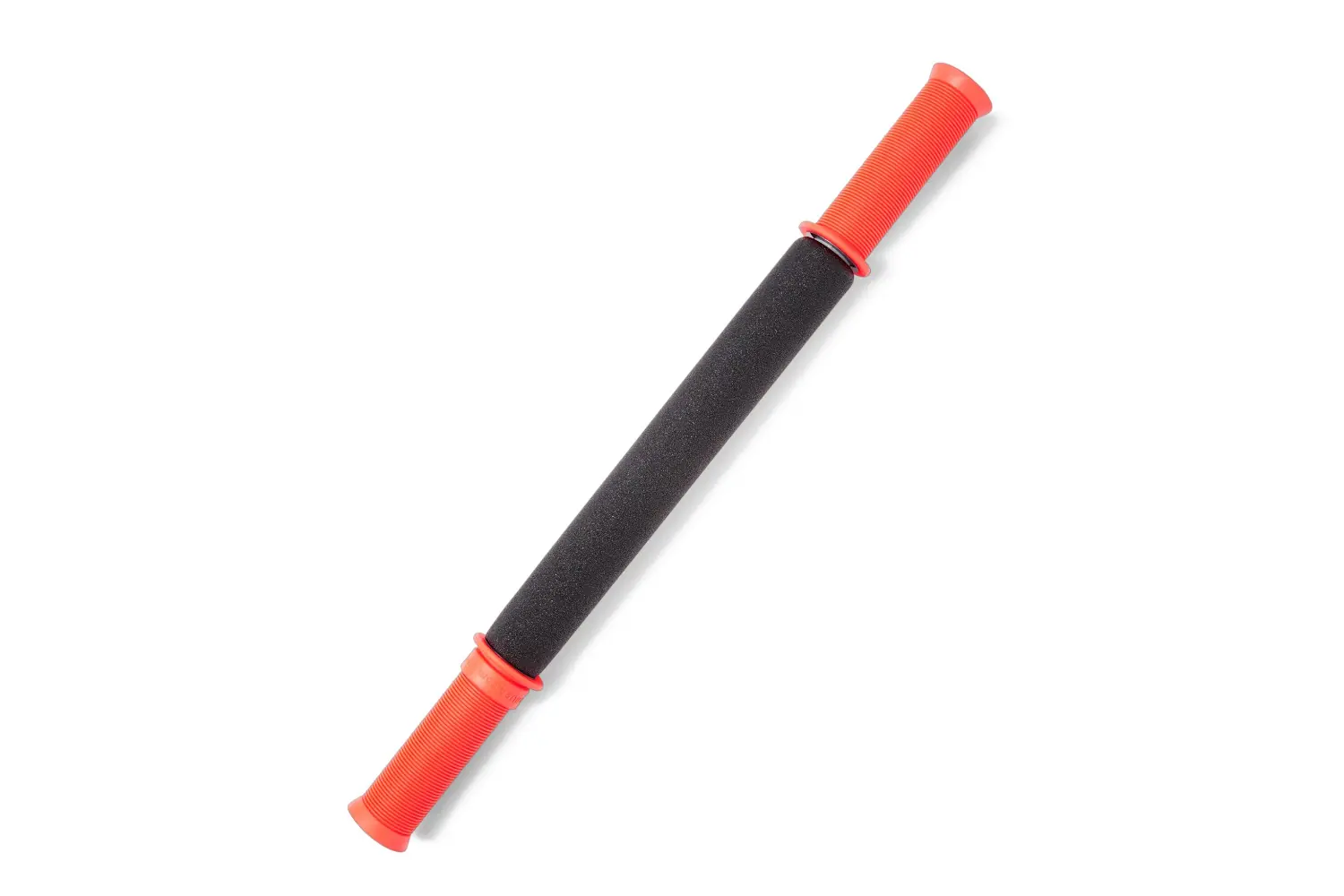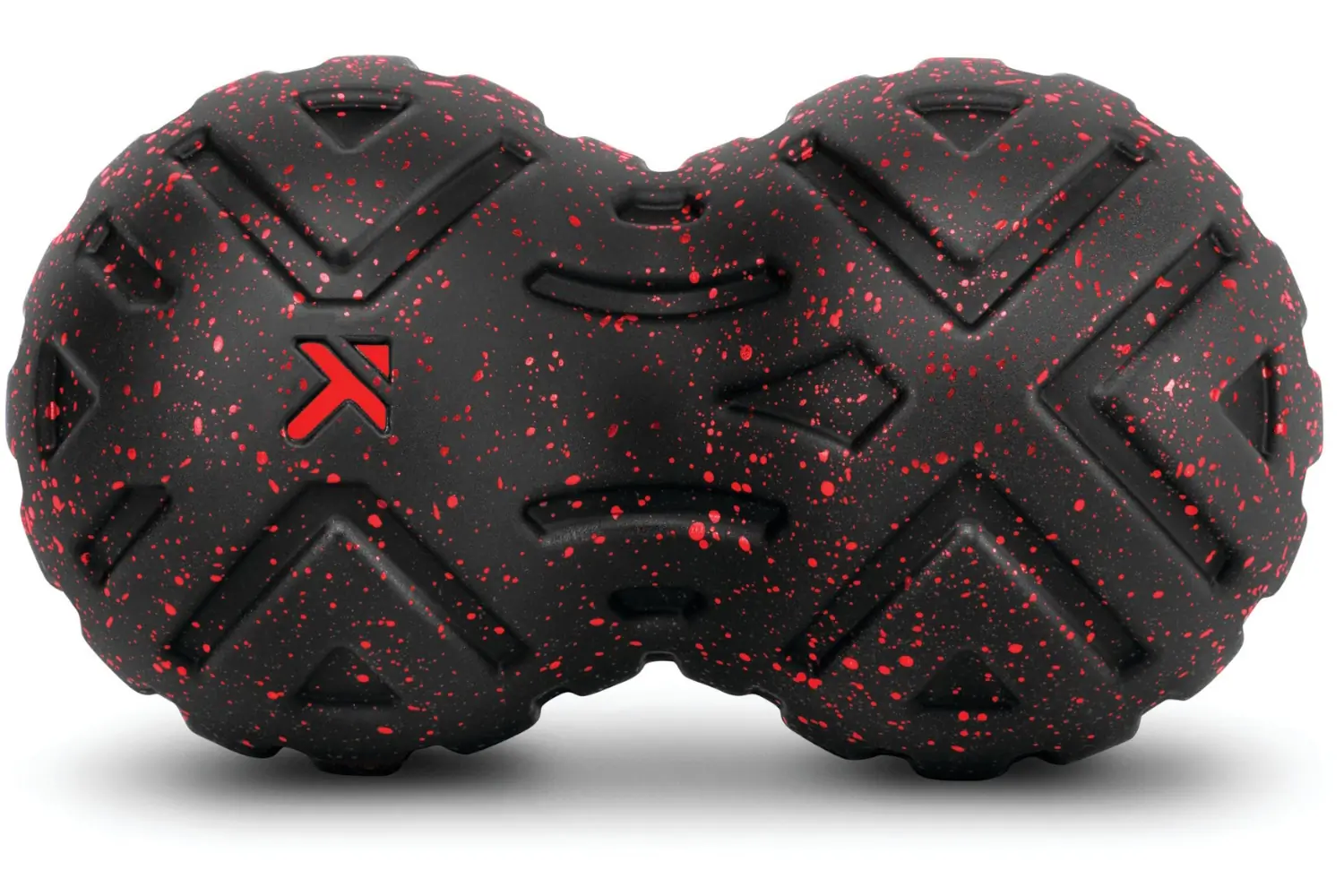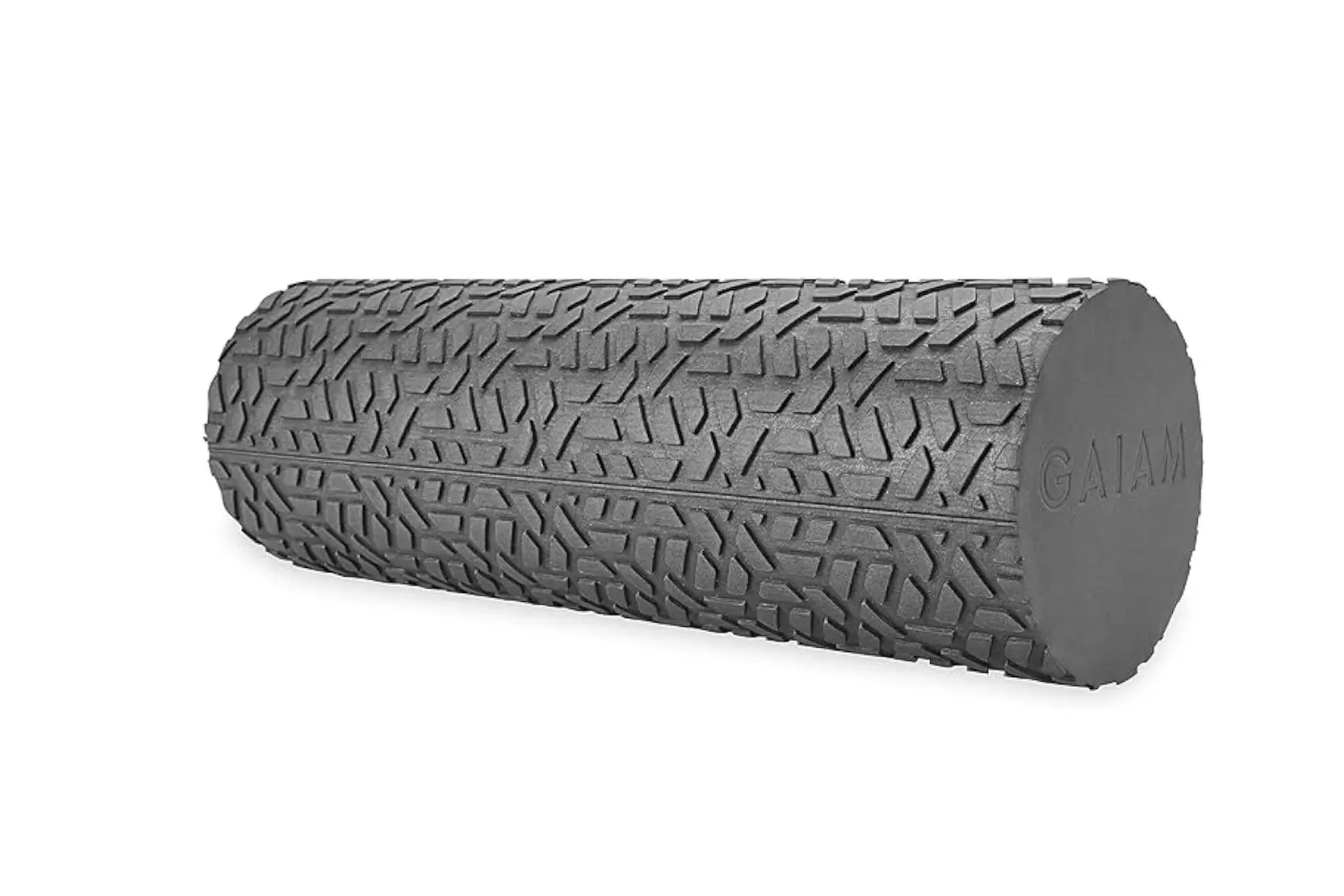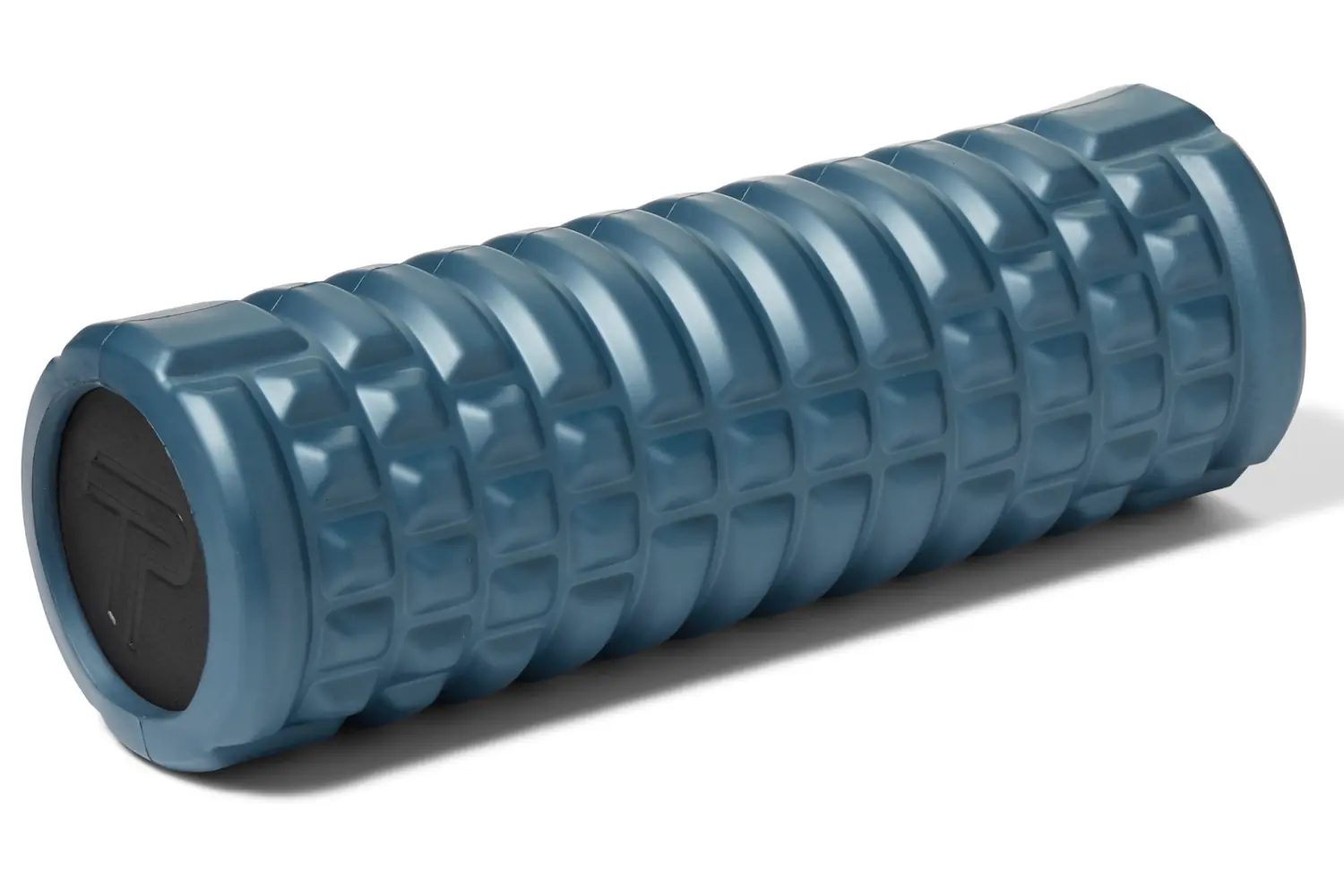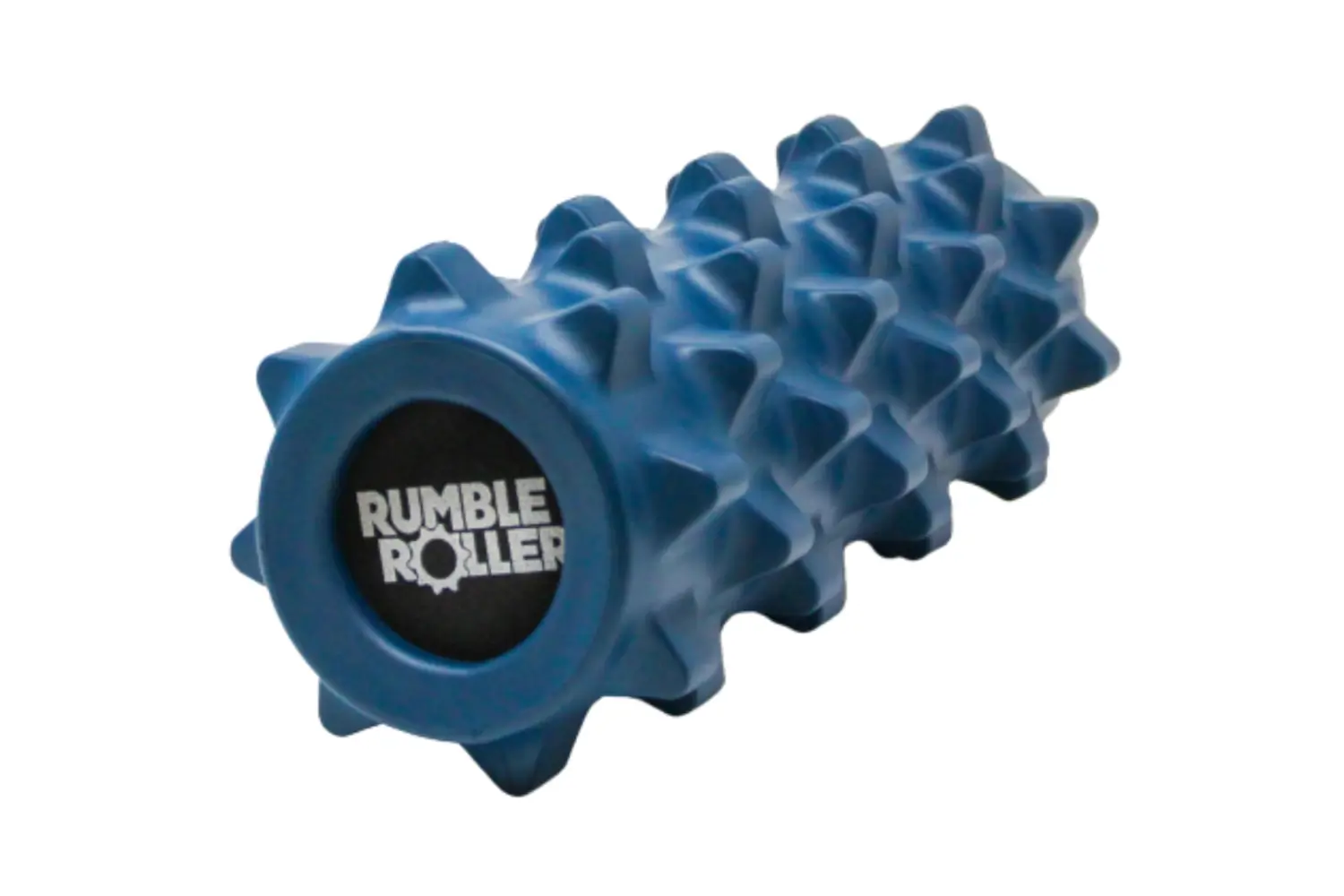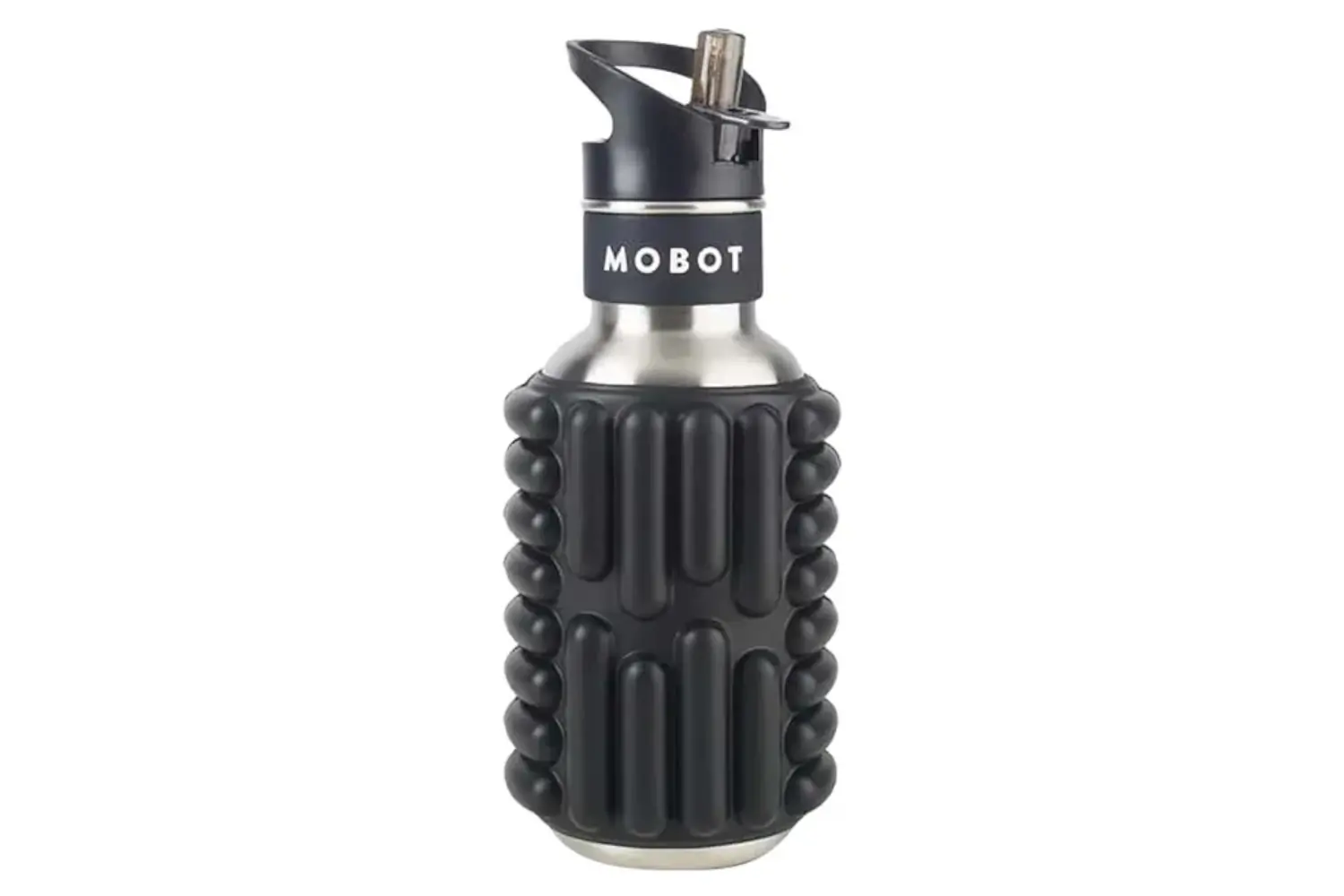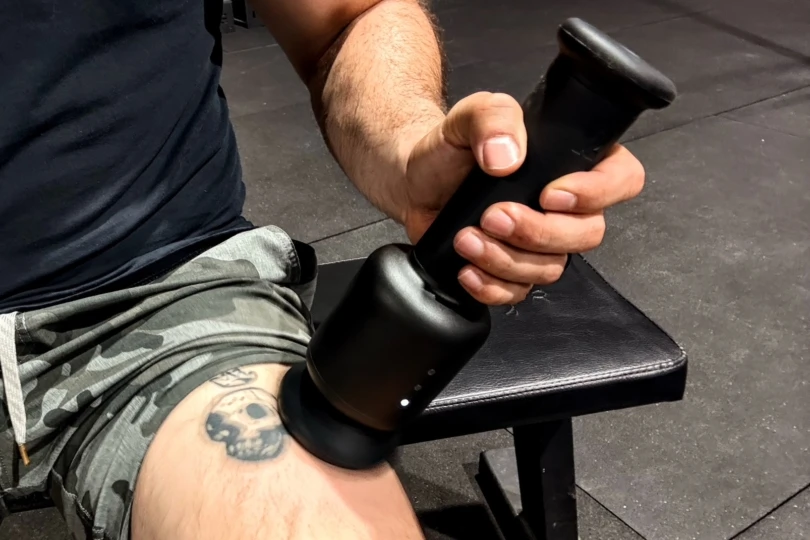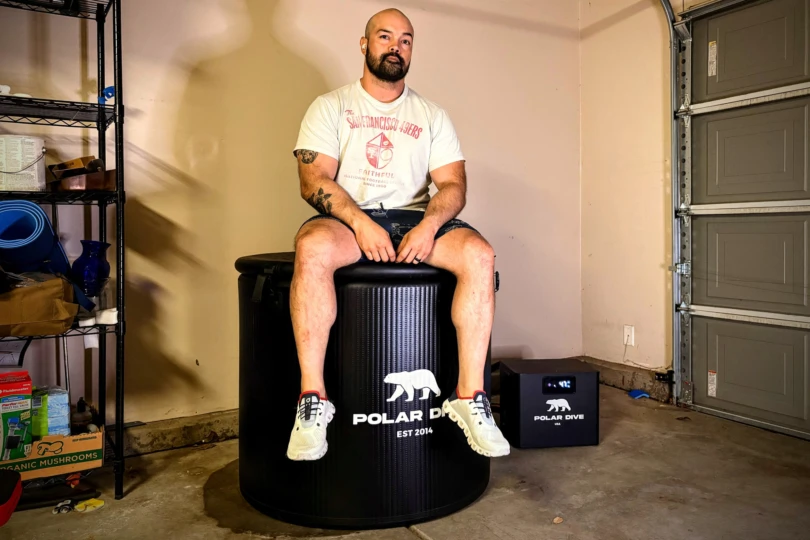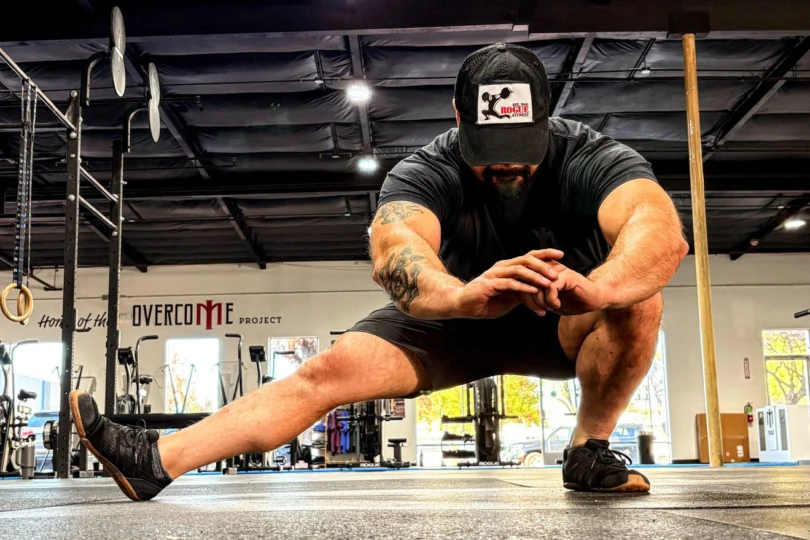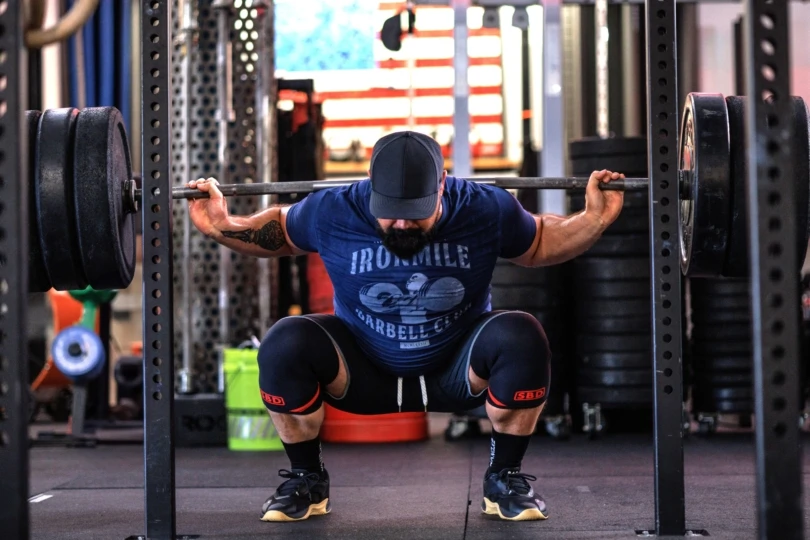Whether we’re working at a desk, lifting weights, or skiing moguls, our muscles get worked; in recent years, the best foam rollers on the market have gained traction as a key recovery tool. There are tons of foam rollers on the market, but they’re not all built the same. So we did the work to see which ones are the best for every application.
We tested the best foam rollers using a systematic evaluation regime to ensure each roller received equal testing across the board. Each roller was tested for the same duration and on the same muscle groups over a 2-week span. Following our testing, we noted the foam roller’s firmness, length, and texture and identified changes in soreness, mobility, and pain afterward.
Our favorite is the Roll Recovery R4, featuring an anatomically contoured design and high-density EVA foam for targeted muscle relief. If you’re on a budget, the AmazonBasics High-Density Round Foam Roller is affordable and still delivers effective muscle therapy — perfect for beginners.
Editor’s Note: We updated our Foam Rollers guide on October 20, 2024, adding four new products, including the sustainable Oceanfoam Tidal Roller and the foam roller/water bottle MOBOT Portable Travel Foam Roller.
The Best Foam Rollers of 2025
- Best Overall Foam Roller: Roll Recovery R4
- Best Budget Foam Roller: AmazonBasics High-Density Round Foam Roller
- Best Vibrating Foam Roller: Therabody Wave Roller
- Best Portable Foam Roller: Brazyn Morph Collapsible Foam Roller
- Best Massage Wheel: Chirp Wheel PRO
- Best Massage Ball: Rawlogy Cork Massage Ball
- Best Long Foam Roller: OPTP Pro-Roller Soft
- Most Sustainable Foam Roller: Oceanfoam Tidal Roller
Roll Recovery R4
- Materials: High-density EVA foam
- Texture: Rounded bumps
- Dimensions: 18 in. x 6 in.
- Weight: 2 lbs., 9.6 oz.
Pros
- Anatomically contoured face
- A large diameter gives better leverage to apply pressure
- Quality high-density foam is durable
Cons
- Very firm
AmazonBasics High-Density Round Foam Roller
- Materials: Polypropylene foam
- Texture: Smooth
- Dimensions: 18 in. x 6 in.; 24 in. X 6 in; 36 in x 6 in
- Weight: 4.3 oz.
Pros
- Affordable
- Simple, firm construction
- Different designs and sizes available
Cons
- Not very durable
- Slightly raised seams can be irritating
Therabody Wave Roller
- Materials: Hypo-allergenic high-density EVA foam
- Texture: Smooth
- Dimensions: 12 in. x 5 in.
- Weight: 3 lbs., 4.8 oz.
Pros
- Vibration technology increases therapeutic potential
- Five customizable vibration frequencies
- Improves range of motion
- Quiet
Cons
- Expensive
- Heavy
- Some may consider the length too short
Brazyn Morph Collapsible Foam Roller
- Materials: Bamboo, aluminum, foam
- Texture: Raised nubs
- Dimensions: 15.5 in. x 6.5 in. (2 in. wide when flattened)
- Weight: 1 lb., 9.6 oz.
Pros
- Most portable roller on the market
- Hits all targeted muscle groups
- Eco-friendly design
Cons
- Can collapse during use
- Ridge design isn’t comfortable for everyone
- More expensive than standard rollers
Chirp Wheel Pro
- Materials: EVA foam, ABS plastic
- Texture: Dimpled and contoured
- Dimensions: 5 in. x 8 in.
- Weight: 3 lbs., 2.6 oz.
Pros
- Unique design targets muscles between shoulder blades
- Vibration helps to unlock tension in spine
- Long battery life
Cons
- Less versatile for other muscle groups
- Proprietary charger
Rawlogy Cork Massage Ball
- Material: 100% sustainable cork
- Texture: Smooth
- Dimensions: 1.9 in., 2.5 in.
- Weight: 0.7 oz., 1.4 oz.
Pros
- Light and packable
- Great for targeting small muscles
- Sustainable materials
Cons
- Less effective for targeting big muscle groups
OPTP Pro-Roller Soft
- Materials: EVA foam
- Texture: Smooth
- Dimensions: 36 in. x 4 in.
- Weight: Varies
Pros
- Soft foam for a gentle massage
- Ideal for newcomers to foam rolling
- Available in various size options
Cons
- Won’t be the best for deep tissue work
Oceanfoam Tidal Roller
- Materials: Post-industrial recycled EVA foam, bloom algae pellets
- Texture: Wave
- Dimensions: 20 in. x 5 in. x 5 in,
- Weight: 1 lbs., 14 oz.
Pros
- Made with more eco-friendly materials
- Wave design feels great while in motion
- Available in many color options
- Firm
Cons
- Limited deep tissue relief
TriggerPoint GRID Foam Roller
- Materials: EVA foam
- Texture: Gridded
- Dimensions: 13 in. x 5.5 in.
- Weight: 1 lb., 8 oz.
Pros
- Hyper-focused therapy techniques
- Light and durable
- Trusted brand
Cons
- Length of roller is too short for some
- Some may find the diameter to small to get leverage
- Materials: Closed-cell, non-porous, zero rubber/latex, non-deteriorating, non-absorbing foam
- Texture: Flat foam
- Dimensions: 18 in. x 10 in.
- Weight: 10.4 oz.
Pros
- Highly portable
- Ergonomic design
- Can access hard-to-reach areas
- Easy to keep clean
Cons
- Limited application
- Very firm
- Materials: Closed-cell polyurethane foam
- Texture: Distinct texture and dual-ball design
- Dimensions: 9 in. x 8 in. x 5.3 in,
- Weight: 14.4 oz.
Pros
- Effective muscle targeting
- Portable design
- Deep tissue access
- Durable, firm materials
- Works well for spine and neck release
Cons
- Not the most versatile
- Too firm for users that prefer gentle massage
- Materials: Foam
- Texture: Lightly textured
- Dimensions: 18 in. x. 6 in.
- Weight: 13.9 oz.
Pros
- 15-minute digital workout included
- Incredibly lightweight
- Good length for more stretches
Cons
- Some may find the firmness too soft
- Not as durable as others
- Materials: High-density EVA foam
- Texture: Raised contours
- Dimensions: 14 in. x 5 in.
- Weight: 16 oz.
Pros
- Lightweight and portable
- Highly durable
- Great for deep tissue massage
- Good for targeting smaller muscles
Cons
- Some may find the firmness and texture too aggressive
- Makes a crinkling sound when in use
- Materials: EVA Foam
- Texture: High-profile bumps
- Dimensions: 13 in. x 5 in.
- Weight: 14 oz.
Pros
- Great soft tissue massage
- Perfect tool for warming up
Cons
- Doesn’t apply pressure evenly
- Materials: Polypropylene foam
- Texture: Contoured
- Dimensions: 13 in. x 5.4 in.
- Weight: 2 lbs., 11 oz.
Pros
- Vibration technology increases therapeutic potential
- Improves range of motion
- Durable design
Cons
- Expensive
- Short battery life
- Materials: Expanded polypropylene (EPP) foam
- Texture: Smooth
- Dimensions: 12 in. x 3 in.; 18 in. x 3 in.; 36 in. x 3 in.
- Weight: 3.1 oz., 3.9 oz., 6.7 oz. (depending on dimensions)
Pros
- Affordable
- Simple, functional design
- Full and half-round options
Cons
- Not the most durable
- Too firm for some folks
- Materials: High-density non-toxic EVA foam, recycled stainless steel
- Texture: Trigger point
- Dimensions: 11 in. x 4.5 in.
- Weight: 13.7 oz.
Pros
- 3 size options
- Eco-conscious materials
- Highly portable
- Doesn’t leak even while in use
Cons
- Bulky and awkward to hold
- About as effective as a Nalgene for rolling
- Hard to clean
Foam Roller Comparison Chart
| Foam Roller | Price | Materials | Texture | Dimensions | Weight |
|---|---|---|---|---|---|
| Roll Recovery R4 | $60 | High-density EVA foam | Rounded bumps | 18 in. x 6 in. | 2 lbs., 9.6 oz. |
| AmazonBasics High-Density Round Foam Roller | $10-19 | Polypropylene foam | Smooth | 18 in. x 6 in; 24 in. X 6 in; 36 in x 6 in | 4.3 oz. |
| Therabody Wave Roller | $149 | High-density EVA foam | Smooth | 12 in. x 5 in. | 3 lbs., 4.8 oz. |
| Brazyn Morph Collapsible Foam Roller | $75 | Bamboo, aluminum, foam | Raised nubs | 15.5 in. x 6.5 in. (2 in. wide when flattened) | 1 lb., 9.6 oz. |
| Chirp Wheel Pro | $150 | EVA foam, ABS plastic | Dimpled and contoured | 5 in. x 8 in. | 3 lbs., 2.6 oz. |
| Rawlogy Cork Massage Ball | $12-14 | 100% sustainable cork | Smooth | 1.9 in., 2.5 in. | 0.7 oz., 1.4 oz. |
| OPTP Pro-Roller Soft | $29-52 | EVA foam | Smooth | 36 in. x 4 in. | Varies |
| Oceanfoam Tidal Roller | $58 | Post-industrial recycled EVA foam, bloom algae pellets | Wave | 20 in. x 5 in. x 5 in, | 1 lbs., 14 oz. |
| TriggerPoint GRID Foam Roller | $37 | EVA foam | Gridded | 13 in. x 5.5 in. | 1 lb., 8 oz. |
| Tiger Tail Foam Roller Massage Stick | $40 | Closed-cell, non-porous, zero rubber/latex, non-deteriorating, non-absorbing foam | Flat foam | 18 in. x 10 in. | 10.4 oz. |
| Trigger Point Performance Universal Massage Roller | $25 | Closed-cell polyurethane foam | Distinct texture and dual-ball design | 9 in. x 8 in. x 5.3 in, | 14.4 oz. |
| Gaiam Restore Foam Roller | $20 | Foam | Lightly textured | 18 in. x. 6 in. | 13.9 oz. |
| Pro-Tec Contoured Roller | $35 | High-density EVA foam | Raised contours | 14 in. x 5 in. | 16 oz. |
| RumbleRoller Original Textured Foam Roller | $50-75 | EVA foam | High-profile bumps | 13 in. x 5 in. | 14 oz. |
| Hyperice Vyper 3.0 | $199 | Polypropylene foam | Contoured | 13 in. x 5.4 in. | 2 lbs., 11 oz. |
| ProsourceFit High-Density Foam Rollers | $12-22 | Expanded polypropylene (EPP) foam | Smooth | 12 in. x 3 in.; 18 in. x 3 in.; 36 in. x 3 in. | 3.1 oz., 3.9 oz., 6.7 oz. |
| MOBOT Portable Travel Foam Roller Big Bertha | $65 | High-density, nontoxic EVA foam, recycled stainless steel | Trigger point | 11 in. x 4.5 in. | 13.7 oz. |
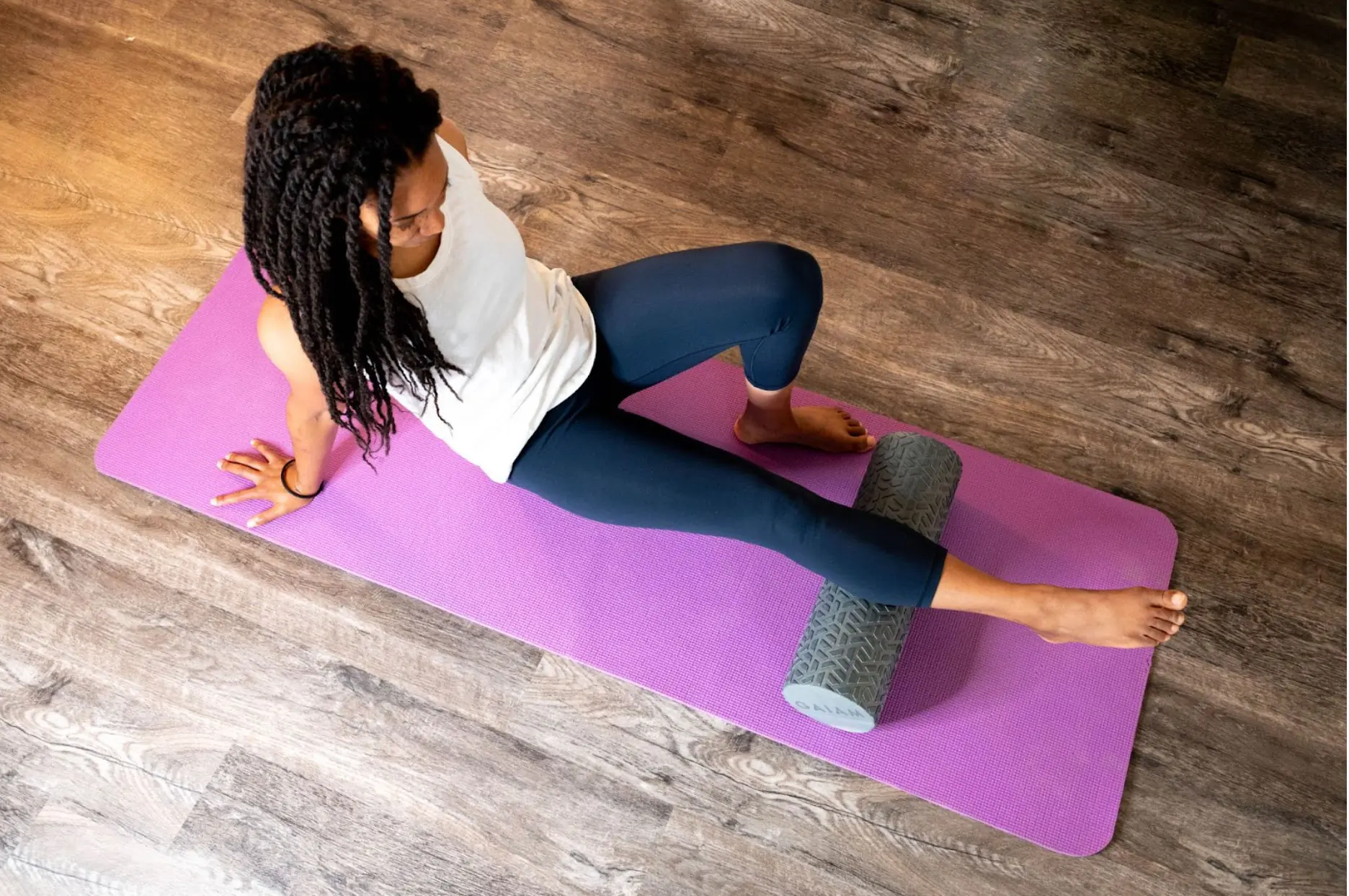
How We Tested Foam Rollers
Our Testing Process
Our GearJunkie team of gear testers includes hikers, runners, climbers, skiers, and outdoor adventurers, and we constantly put our bodies to the test. We are weekend warriors who walk dozens of miles in the mountains with overnight packs on our days off. We’re also professional guides that rely on our physical abilities to pay the bills.
As outdoor recreationists, we know firsthand the importance of good recovery. After a big objective in the mountains, rolling out and stretching sore muscles is key to getting outside again as soon as possible. It’s also key to enjoying everyday life with better mobility, flexibility, injury prevention, and stress relief.
While testing for the best foam rollers, we considered and used a wide variety of shapes, materials, densities, and sizes for a range of applications and targeting various body areas. In addition to our objective tests and personal experience, we also consider the most innovative, popular, novel, and legacy products available today. These foam rollers serve a range of athletes, muscle groups, storage needs, and price points.
Firmness, length, durability, and texture were cross-referenced with any changes in mobility, discomfort, or pain during a daily rotation of 15-minute testing sessions over 2 weeks.
Our Expert Testers
Our foam roller testing began in 2021 with seven rollers and the aim of bringing together the best rollers available for releasing tension in active outdoor people. Our choices reflected a broad consideration of the market and took into account not only the opinions of active coworkers and friends but also of the physical therapists we trust our bodies to.
We expanded our roller horizons in 2022 when tester and climbing guide Katie Griffith researched alternative roller styles and added massage wheels and massage balls to the mix, bringing with her the knowledge of a life spent living out of her converted van and the aches that can sometimes accompany that.
Then, Rebecca Ross refined our foam roller testing regiment while evaluating several additional foam rollers on our list. With a Master’s degree in public health, she has spent time analyzing the way we test foam rollers to ensure the most equitable and fair comparison.
For our most recent update, Meg Carney tested four new models. With a background in health and wellness and a passion for pushing herself in the outdoors, she is the ideal expert to round out this guide. If you’d like to add other recovery practices to your foam rolling practice, check out our guides to the best yoga mats, best massage guns, and best foot massagers.


Buyer’s Guide: How to Choose a Foam Roller
Differences in firmness, length, texture, and portability all affect the choice of a foam roller, and each variable serves its purpose.
Foam Type
There are a handful of materials used for foam rollers with the most common on our list being Polyethylene (PE), Expanded Polypropylene (EPP), and Ethylene Vinyl Acetate (EVA).
Soft foam rollers are made from PE and tend to be the least durable. A much stronger version is EPP, used in the AmazonBasics High-Density Round Foam Roller, which has many of the same properties as PE, but is considered one of the more dense foams out there. Both PE and EPP are not the most durable, since they easily show signs of wear. However, with care, they can be incredibly long-lasting.
Most on our list are made from EVA, like the RumbleRoller Original Textured Foam Roller, and that’s because it’s highly tear-resistant, making it more durable but also more expensive. EVA-made foam rollers are not as dense as EPP-made ones, but “high-density EVA” is tougher than regular EVA rollers.
Of course, there are alternative materials as well, including bamboo, which is used in the Brazyn Morph Collapsible Foam Roller together with foam and aluminum, or even cork, which is used in the Rawlogy Cork Massage Ball, to name a couple.


Firmness
Arguably, the most important factor in choosing a foam roller is its density or firmness. Soft rollers may not provide the level of massage required for deep muscle soreness, and excessively hard rollers can cause bruising or trauma if not used correctly.
In some cases, the color of a foam roller can help identify firmness; for instance, foam that is lighter in color tends to be softer, whereas foam that is darker tends to be firmer. However, because standards can vary from brand to brand, it is not always straightforward to identify firmness based on color or material alone.
Because of this, we measured firmness by measuring the amount of pliability or “give” after applying pressure. A generous amount of “give” was considered soft, while no “give” at all was considered hard, and anything in between was considered medium.
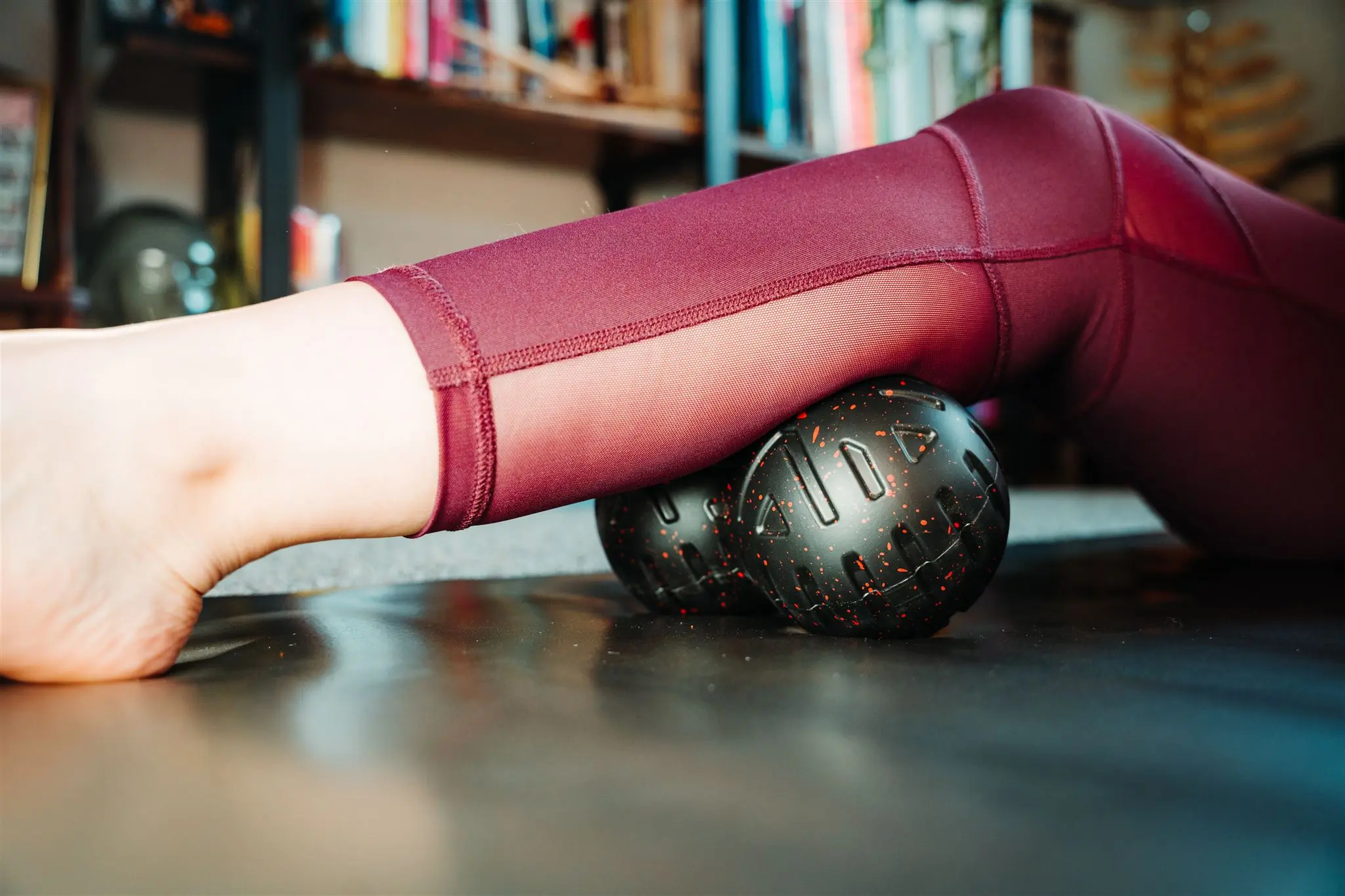



With a fair amount of pliability, the OPTP Pro-Roller Soft, is considered a soft roller and is designed to prioritize comfort over deep tissue massage. Less-firm rollers are suitable for those with sensitive muscles or who are new to foam rolling. As you improve your technique and your muscles get used to the pressure, you can move up to harder rollers.
Firm rollers like the Roll Recovery R4, which were considered to have no “give” are designed for deep and intense massage and muscle therapy. If you are a very active person, a hard roller like the TriggerPoint Performance Universal Massage Roller can help you target and penetrate deep into sore muscles. This style of roller is also ideal for myofascial release.
Rollers with a medium-level firmness can, as you may imagine, do it all. They are suitable for both massage and yoga or Pilates exercise routines. Proper use will still allow you to access deep tissue while maintaining the comfort and cushion found in less-firm rollers.


Length
As with firmness, different lengths serve different purposes, and it is up to you to decide what is most important for your specific muscular needs.
Long or full-size rollers generally measure around 36 inches in length. At this length, these rollers are suitable for larger muscle groups. Full-size rollers allow you to access your entire back when laid perpendicular to your spine.
These rollers are also great for other large muscle groups like those found in your upper leg. The longer length also lends itself well to many Pilates or core exercises that require you to lay it vertically along your back.
Shorter rollers, 24 inches or less, are excellent for pinpointing smaller muscle groups like specific areas of your back, arms, or legs. If you have isolated problem areas around your body, a shorter roller may be a perfect choice. As a bonus, the shorter lengths are also more portable.
If your persistent knots are in hard-to-reach areas, specifically shaped rollers like the Chirp Wheel Pro can target muscles that a regular foam roller of any length might miss.
Diameter
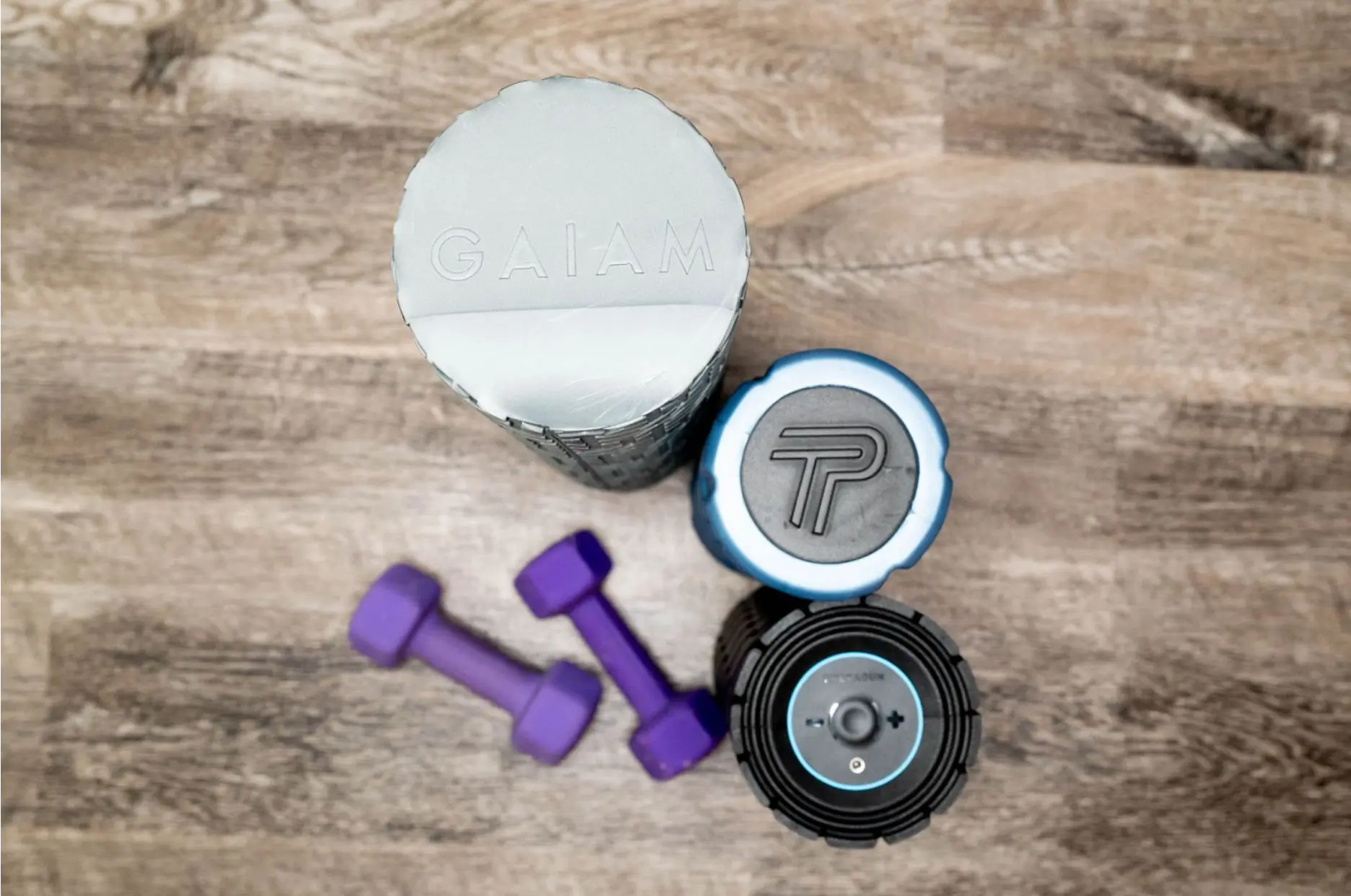



The diameter measures how thick the foam roller is or the circumference. Foam rollers with larger diameters can be easier to apply more pressure because you can get more leverage on them.
The most popular diameter seems to be around 5 inches. We would not recommend buying anything less for a general-use foam roller because it can be hard to press down on it. Typically foam rollers with smaller diameters are specially made for calves, soleus, or Achilles.
The Roll Recovery R4 was one of the largest diameters we tested at 6 inches, making it easy to apply a lot of weight.
Portability
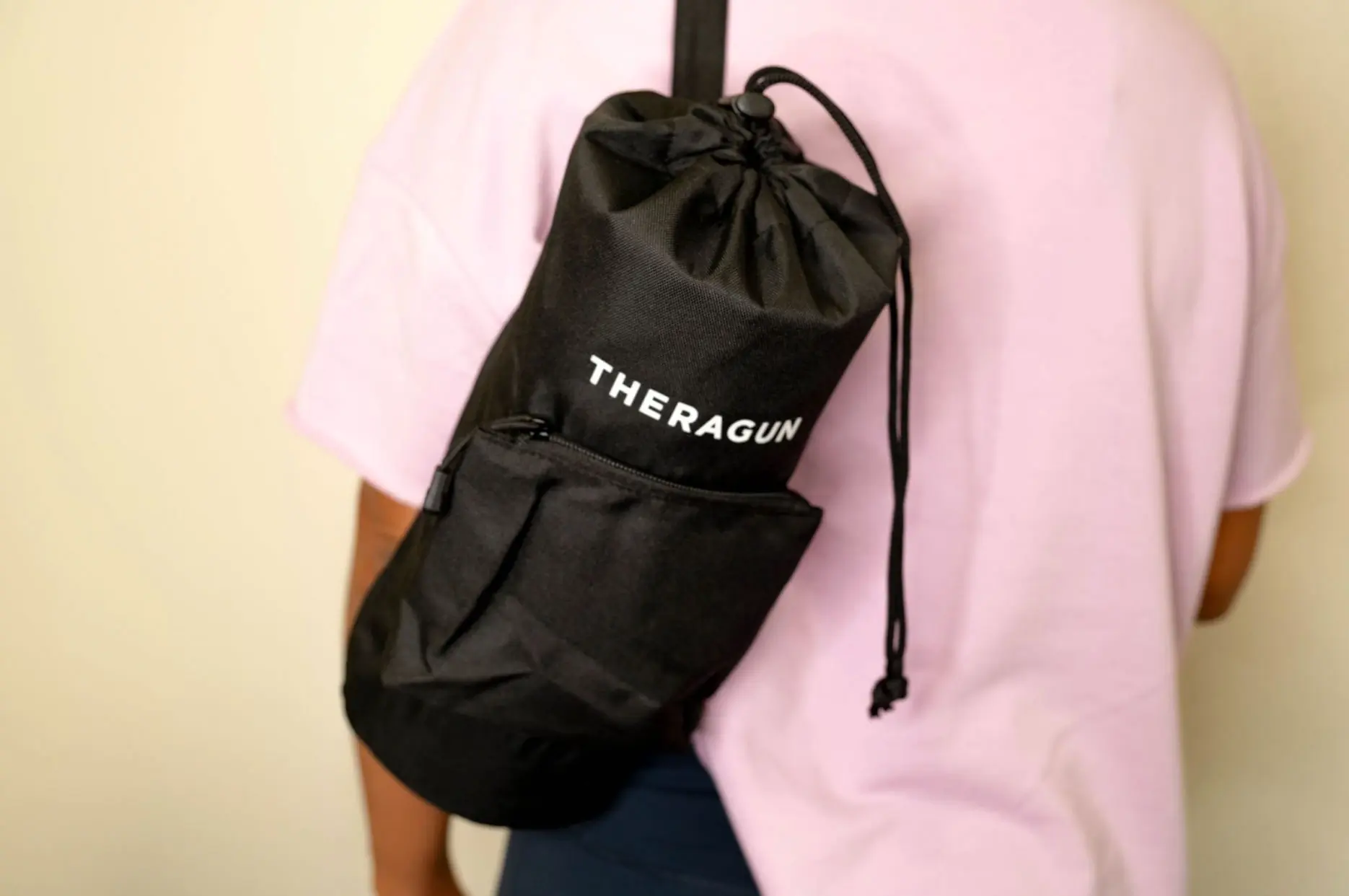



Your foam roller’s portability is a worthy consideration depending on your lifestyle and level of muscle soreness. If you only plan on using a roller occasionally or at home, perhaps you won’t have to worry about how easy it is to bring with you.
If you have chronic muscle pain and travel a lot for business or pleasure, more portable options like the Brazyn Morph Collapsible Foam Roller and Tiger Tail Foam Roller Massage Stick are the way to go.
Some rollers are explicitly designed with portability in mind, like the Rawlogy Cork Massage Ball. Still, even if not designed for portability, many shorter rollers can easily fit in a standard gym bag.
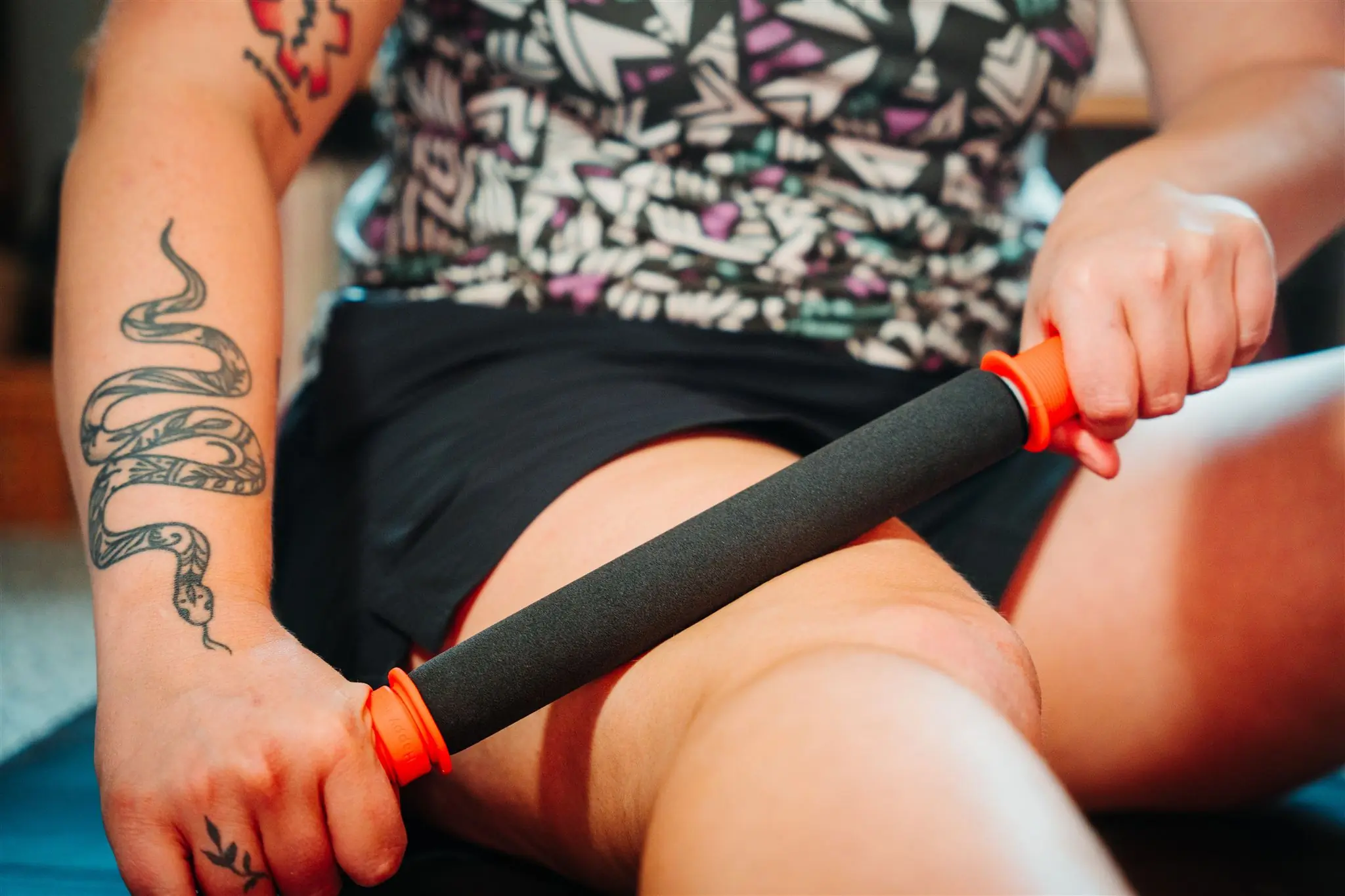



Texture
The texture is another noticeable difference between foam rollers. The differences can be spelled out simply between smooth and textured rollers.
Smooth rollers are traditional and have been the go-to for some time. They provide equal pressure across the targeted area, but may be limited in reaching deep muscles or tendons. During our 15 minutes of testing, we discovered that raised textured foam rollers produced the most noticeable improvement in enhanced flexibility and release of myofascial trigger points compared to smoother textures.
Like softer rollers, smooth rollers are a good choice for beginners, as they are not as intense as their textured counterparts. Generally speaking, smooth rollers are also often more affordable.
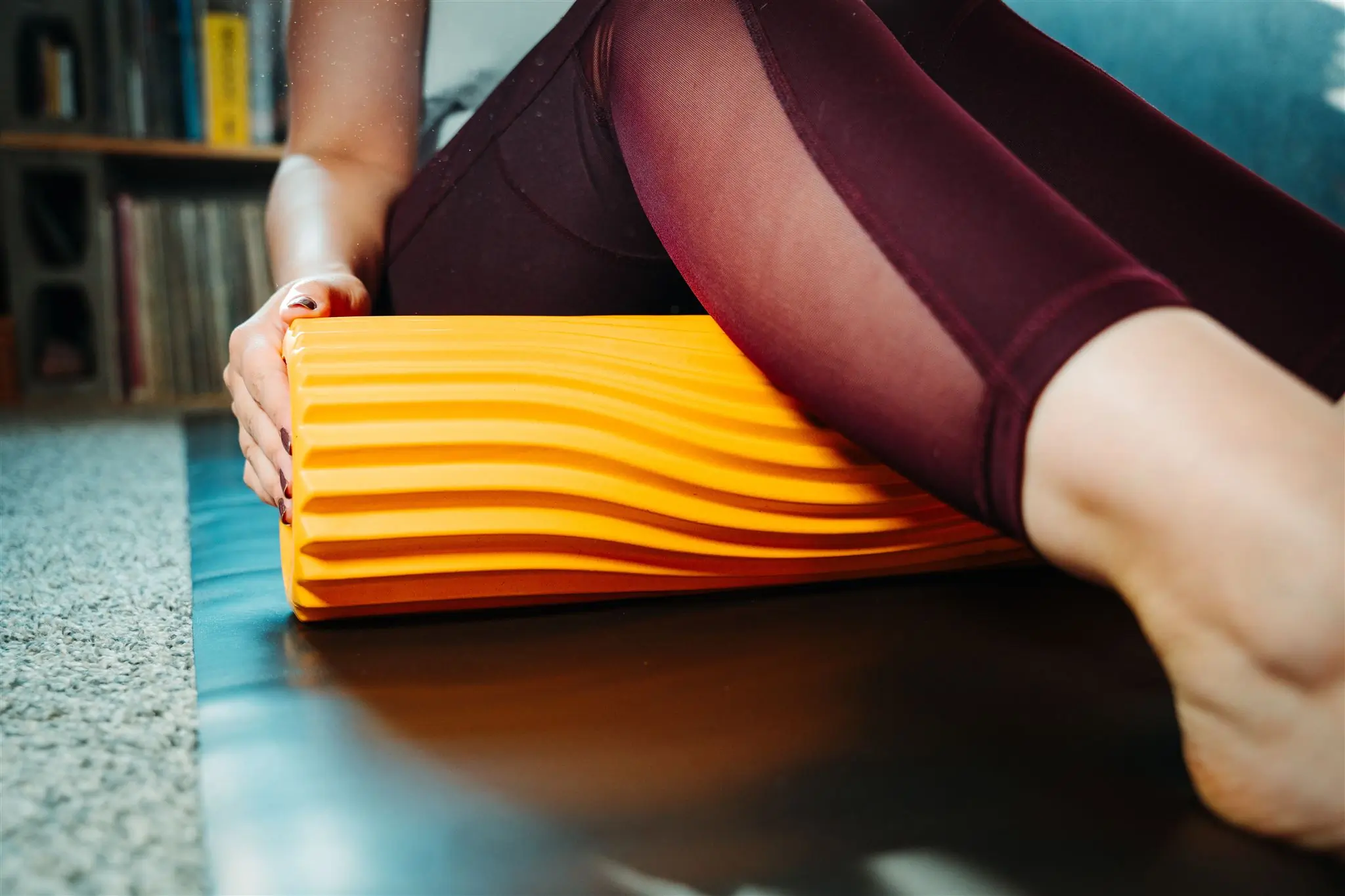



Textured rollers are more advanced and better suited for users comfortable with their rolling technique. The added features on these rollers, like ridges and bumps, are meant to precisely target problem areas. Our most sustainable option, the Oceanfoam Tidal Roller has a unique wave texture pattern that sets is apart from others.
Textured rollers — like the Pro-Tec Contoured Roller below — will often have multiple features on one roller to promote customization. They are specifically designed to target specific muscle groups for the best massage, mimicking a massage therapist’s hands, and are a good way to isolate knots or problem areas.
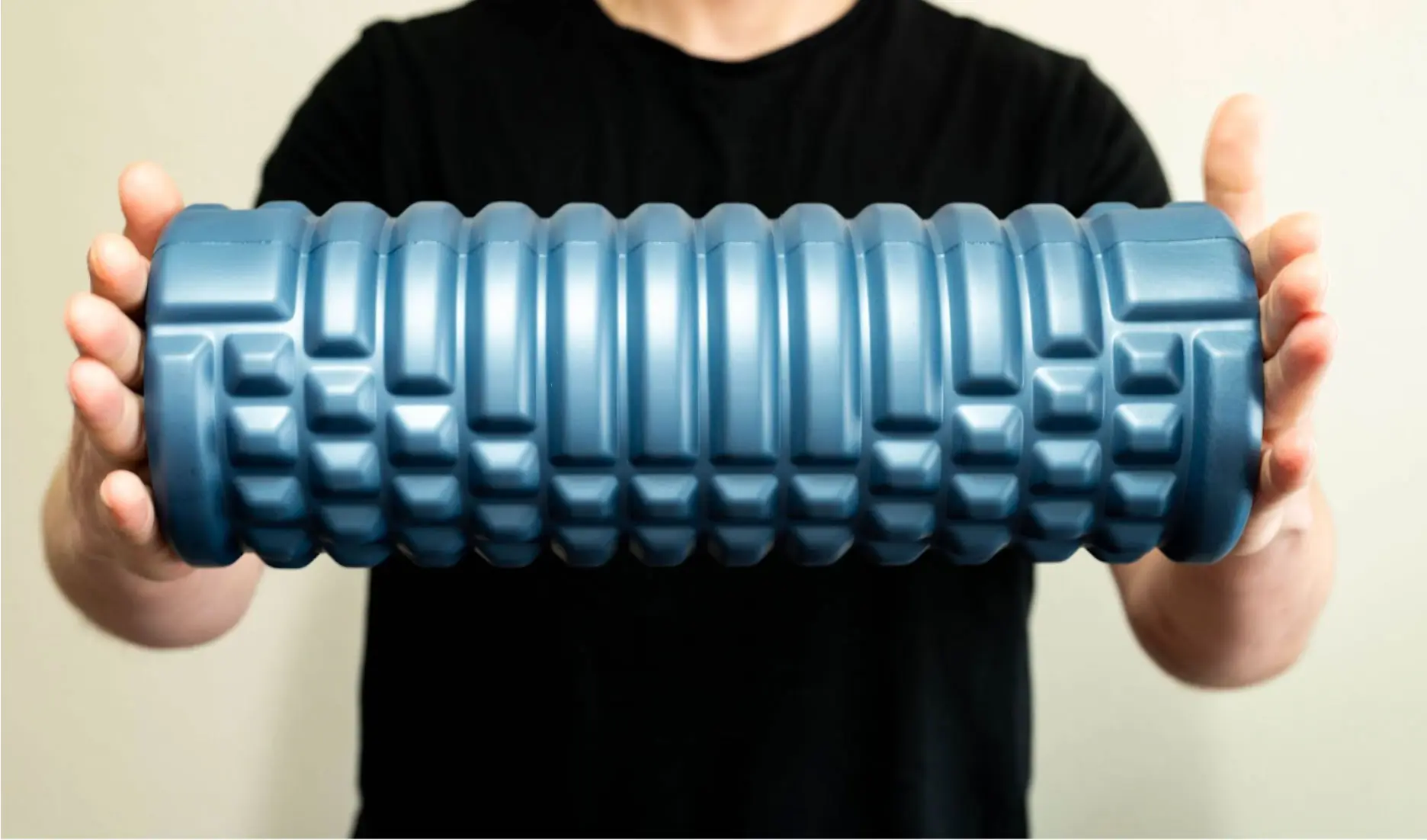



Extra Features
Without a doubt, the six features outlined above are the most important things to consider when shopping for the best foam roller for back or muscle issues. That said, there are a few other considerations to take into account.
For many, outdoor fitness and environmental ethics go hand in hand. If that is important to you, some companies are producing their rollers from recycled or sustainable materials.
Some foam rollers and materials are also better suited for yoga and Pilates workouts than strictly rolling. If you plan on using your roller for exercise routines, this is a good thing to keep in mind. Or, if you need your roller to do double duty at the gym, consider the MOBOT Portable Travel Foam Roller, which doubles as a water bottle.
Half-round foam rollers are an alternative for those who may have difficulty balancing their body weight on a cylindrical or ball-shaped roller. Half-round foam rollers, like the ProsourceFit High-Density Foam Rollers, are also available in a range of lengths and diameters to help keep you stabilized while exercising or stretching.
Vibrating foam rollers are rising in popularity, and that’s because of their unique dual advantage. In addition to offering the same benefits we enjoy from conventional rollers, they also offer a localized vibrational therapy that has shown statistical significance for the body, including enhanced blood flow, less muscle soreness, and improved stability, among others. Vibration foam rollers can be an excellent investment, but keep in mind that they are heavier, require a charge, have fewer length options, and are much more expensive.
Finally, there are virtually limitless colors and patterns available. Naturally, this is a fun — albeit functionally inconsequential — feature to consider when purchasing your first foam roller.
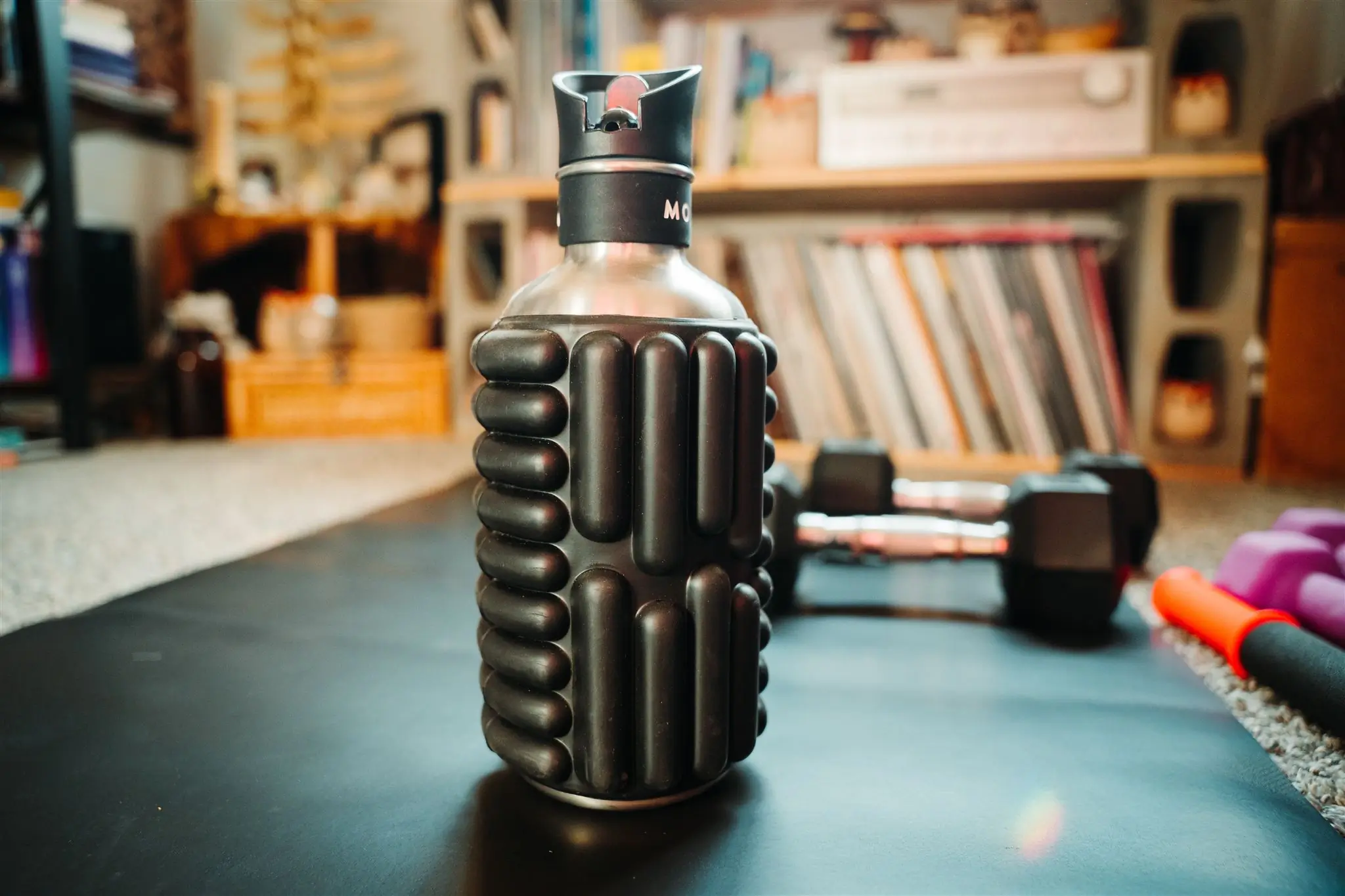



Price & Value
Foam rollers can cost anywhere from around $10 to over $150. This means there’s a foam roller out there for virtually any budget.
Budget
Our budget-friendly options are foam rollers under $20. These rollers are typically made from PE, EPP, or other materials like cork and are generally simple in design. In the budget category, you’ll find solid introductory options like the AmazonBasics High-Density Round Foam Roller ($10-19) and the Gaiam Restore Foam Roller ($20).
These affordable choices provide functionality for newcomers but sacrifice durability and performance; for example, the AmazonBasics model is lightweight and simple but not designed to withstand heavy use, and the Gaiam Restore offers a softer touch that might not effectively target deeper muscle tension.
Mid-Tier
Moving into the mid-tier, you can expect to spend between $25 and $75. Mid-range foam rollers are typically made with EVA, are more durable, and have more features including ridges, bumps, nubs, and contours. In this range, products like the TriggerPoint Performance Universal Massage Roller ($25) and the Pro-Tec Contoured Roller ($35) stand out.
Spending more in this range gives you enhanced features and better material quality; the TriggerPoint roller provides effective muscle targeting with its unique design, while the Pro-Tec offers a firm, contoured surface for deep tissue relief. These are more durable and versatile than budget picks, but they still do not deliver the same level of performance as premium models, particularly for users who require specialized features like vibration technology.
Premium
The premium category ranges from $75 to $200, including options like Therabody Wave Roller ($149) and Hyperice Vyper 3.0 ($199). Premium rollers justify their price with advanced features such as vibration technology and innovative designs that enhance recovery.
For instance, the Therabody Wave Roller offers customizable vibrations for an intense therapeutic experience. While these high-end models deliver exceptional performance and durability, most casual users may find that mid-tier options meet their needs adequately without the hefty price tag.
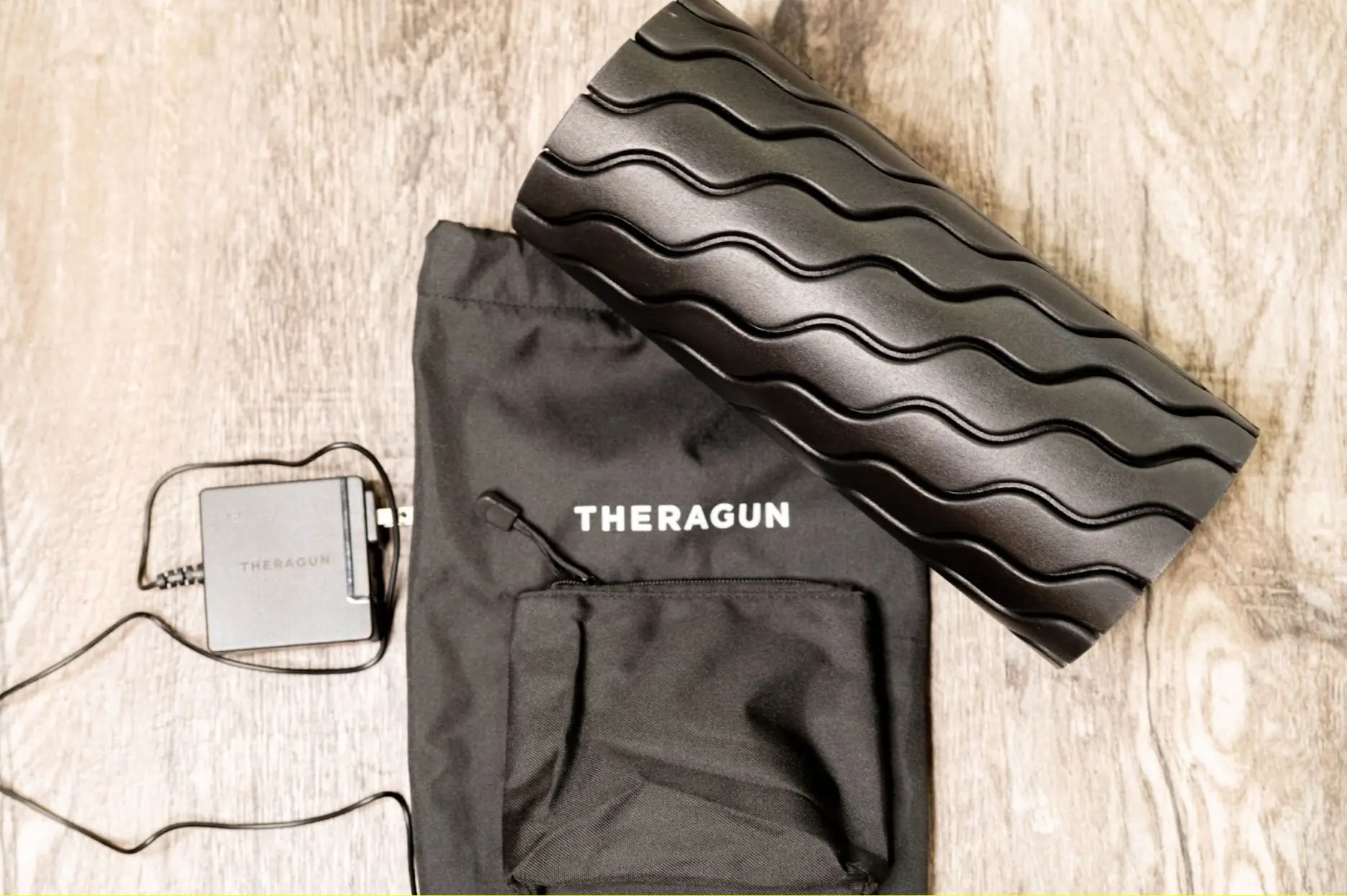



Frequently Asked Questions
Back issues are not to be taken lightly. Small bothers can quickly become chronic problems with little warning. If you have considerable and consistent back pain and soreness, we recommend seeing a professional to address the issue.
That said, foam rollers can be an incredible addition to your self-care tool kit. An ounce of prevention is worth a pound of cure, and foam rollers can do wonders in preventing back issues from developing or worsening.
When built into your daily workout or stretching routine, foam rolling can genuinely help relieve tension, tightness, and soreness in your back.
There is a lot to consider when purchasing a foam roller, and the best foam roller for you may not be the best for your friend. Rollers vary most notably in terms of firmness, length, and texture.
You can generally mix and match the best of each category to find the ideal roller for your specific needs.
Sciatica causes pain that can branch down from your lower back through your hips, buttocks, and legs — radiating along the sciatic nerve. While foam rollers are not a cure for sciatica, they can help manage the pain associated with this condition.
Rolling can be a quick and easy way to promote myofascial release. Depending on your level of sciatic pain and your comfort with a roller, it can be a highly effective pain management technique. Given how affordable foam rollers are, most experts recommend that their sciatica patients keep one on hand.
If you have never used a roller before and are apprehensive about the technique or pressure associated with using one, there are plenty of introductory options available. Less-firm rollers are most forgiving on your muscles, and smooth rollers distribute pressure more evenly.
Both of these factors are welcome features for beginners as they ease their way into the world of targeted self-care.
Not only can you foam roll every day, but some experts would also argue that it is an integral part of injury prevention and workout recovery. Some people treat foam rolling just like stretching. They strive to do it before and after every workout to relax tight muscles and to improve flexibility and range of motion.
A caveat, however, is if you start to feel or instigate pain while rolling. Over-rolling muscle groups can cause further pain and bruising, and potentially do more harm than good. Listening to what your body needs is critical when foam rolling.
Foam rolling can feel good — like, really good. However, you can overdo it. For the best results, try targeting an area for 30-90 seconds at a time, resting and stretching for 30 seconds, and then repeating up to two more times.
You should avoid spending any more than 5 minutes on specific muscle groups. And it is better to underwork a muscle group than to overwork it. Overworking an area can cause bruising or even worsen injuries. Remember, foam rollers are meant for prevention and healing. The last thing you want to do is misuse or overuse yours to the point of making muscle pain or tension worse.
Yes. When used properly, foam rollers may help soothe and treat IT band tightness. Many athletes have successfully addressed IT band tightness with regular foam rolling.
From a side plank position, place your bottom thigh on the roller. Using your forearm to support your torso, move your arm so the roller rolls from the side of your hip to the side of your knee and back again. Some discomfort is normal, but stop and rest if you feel excessive pain.


The Best Massage Guns of 2025
We tested some of the best massage guns on the market, including picks from Therabody, TriggerPoint, and Power Plate.
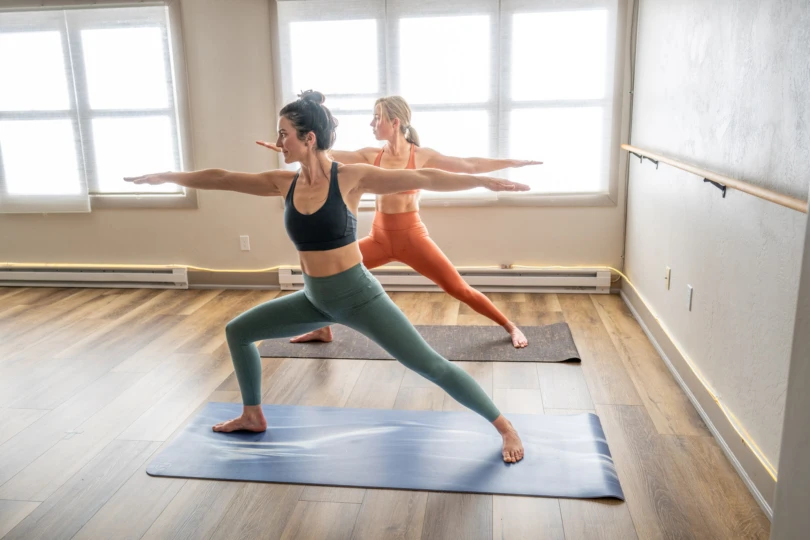

The Best Yoga Mats of 2025
Whether you’re new to yoga or have a lifelong practice, using a comfortable, reliable yoga mat is key. We tested the best yoga mats to help you find yours.
